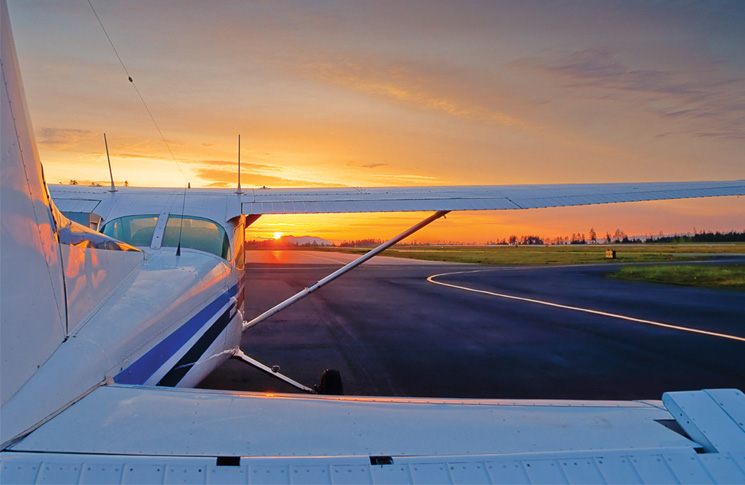By Frank Martinelli
I am a low-hour recreational pilot who flies from Tyabb, a non-controlled airport south of Melbourne. I usually fly alone, or with my wife, and very occasionally with another passenger, every six weeks or so, with a lot of home flight simulation in between actual flights. I fly a Cessna 172.
On this occasion, I was to fly with a friend to circle his family farm at North Foster, with a touch-and-go at Leongatha Airport on the way, and then return to Tyabb. My friend was a very nervous, first-time flier with lots of comments and questions. Despite briefing him and talking about the need for a ‘sterile cockpit’ at critical times (take-off, landing, circuit entry, radio calls etc.), I felt a challenging flight coming on with plenty of chatter and distractions.
Being a low-hour pilot, I am always a little nervous before a flight, but not paranoid. I plan and check meticulously. But the presence of others can easily add to my nervousness, so maybe I was a little more prone to being distracted.
My planning on this occasion included a couple of circuits around Tyabb by myself before my passenger arrived so as to help me settle. I also opted to do an initial circuit with him as well to make sure he was OK before setting off for Leongatha and North Foster. He was fine and as chatty as ever, so off we went.
After leaving the Tyabb circuit and reaching top-of-climb at 3500 ft over French Island, I realised that I had not turned on my transponder. Distraction number one!
During my first CLEAROFF* check I saw that I had not yet changed to the correct area frequency or frequency for Leongatha Airport. Distraction number two!
Approaching Leongatha Airport, and after my 10 nm inbound radio call, I had planned to overfly at 2000 ft AGL to check for traffic and join the circuit crosswind for runway 04. But in between chatter with my passenger, with no other visual or radio traffic, and knowing the airport well, I became somewhat complacent and departed from plan at the last moment and actually joined mid-downwind for runway 04. Distraction number three!
Immediately after my joining radio call I heard an identical joining call, but I could not see any other traffic. While looking for the other aircraft and re-assuring my nervous passenger, I forgot my pre-landing BUMPFH checks. Distraction number four!
I turned base while making my base radio call, only to hear an identical call from the other pilot. I still could not see him. I should have contacted him by radio before now. Distraction number five!
Then I saw him, turning base and coming straight at me! He was mistakenly making a left-hand circuit whereas runway 04 at Leongatha is a right-hand circuit! He must have seen me at this point because we both turned to our right to avoid a collision. We exchanged radio messages, he said he had definitely made an inbound radio call (Did I miss it? Distraction number six?) and he apologised for the incorrect left-hand circuit. We both completed our touch-and-goes and went our separate ways.
Despite the other pilot’s mistake and apology, I was left thinking that some of my distractions may have contributed to an actual close call. Further, some of my other distractions may have been setting me up for other close calls!
Needless to say, after the fright and a few carefully chosen words with my passenger, the rest of the flight was a lot quieter and a lot safer!
But despite the fright and the words, my passenger was warming up to this flying business and asked if we could overfly Tooradin Airport on the way back. This required a small departure from plan. I changed to Tooradin frequency and made the appropriate radio call. Only after the call did I realise that I was saying Tyabb traffic not Tooradin, so I repeated it correctly. Distraction number seven!
Disappointed with myself and determined not to ‘stuff up’ again, I approached Tyabb, entered the circuit, landed and shutdown with every required procedure and check done correctly! I felt a little better!
On reviewing the flight over the next few days, and realising that even small distractions while flying can have serious consequences, I resolved to be firmer in future with passengers and when flying with others to be extra vigilant by double-checking all my normally carefully carried out procedures and checks. I owe it to them and myself!
CLEAROFF is an en-route informal check of:
Compass (aligned with directional gyro)
Log (note ETA, ETD, SARtime)
Engine (check gauges)
Altitude (correct as assigned)
Radio (check frequency)
Orientation (confirm where you are)
Fuel (check sufficient remaining, check correct tank selected)
Forced landing (check for suitable places)
*(Several versions of the CLEAROFF check exist.)



A very good read that was. We’ve all been there being so green & I often wonder how I/we got thru to become experienced drivers with many thousands of hours under our belts.
Flying can be boiled down to about two main things, having the technical skill as in actually flying the machine & the confidence to manage the whole forever changing dynamics of a flight.
Being a little nervous can be a good thing keeps you on yr toes as long as you have the knowledge, a lot of pilots don’t have good aeronautical knowledge & use the ‘nervous’ card to explain their lack of basic airmanship & rules etc.
Remember if it doesn’t feel right then it probably isn’t!
Also there are no dumb questions whilst airborne in a plane:-)
‘Distraction’ can strike ANY pilot (or crew member), no matter how experienced or committed. Accident reports from around the world and from all sectors of aviation ducument Thousands of examples where diverted attenction led to very unfortunate outcomes.
The article is a great reminder.
I’m low time pilot, and I’m very happy to hear that other peoples do mistakes too! :)